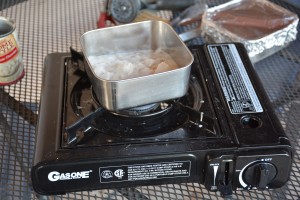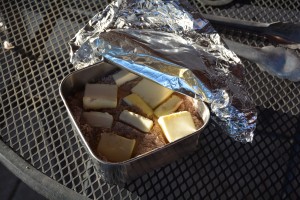Product Review: Not Just for Sack Lunches – U-Konserve To-Go Containers
By Lorrie Baumann
The camping trip I took to Grand Canyon in March didn’t exactly go as planned. Between the trip to the International Home + Housewares Show in Chicago followed immediately by three days in Anaheim, California for Natural Products Expo West and then coming back to the office to send the April issue of Kitchenware News & Housewares Review to print, I didn’t have a whole lot of time for last-minute packing, so when the Saturday morning that started my vacation week came along, I more or less threw my tent and sleeping bag, my campstove and cook pots and my new Lodge dutch oven and a lawn chair into the trunk of my car, and then I packed into my insulated picnic bag a week’s worth of frozen chicken thighs and some foil-wrapped turkey burgers and headed north.
By the time I got to Phoenix, I remembered that although I had the dutch oven, the charcoal and the fire starters and the foil-wrapped food to put in the dutch oven, I’d forgotten my tongs for arranging the coals around the oven. Fortunately, Phoenix has hardware stores, and I found one. Between Phoenix and Flagstaff, I remembered that I was also going to need an oven mitt because the dutch oven was going to be hot coming out of the fire pit.
It wasn’t until I had checked into my campsite at Mather Campground that I reconsidered my ill-advised choice to leave my hard-sided cooler behind once I’d seen how much food actually fit into the insulated picnic bag. Mather Campground is, well, infested is a harsh word, but it fits, so let’s use it. Mather Campground is infested with ravens who seem to enjoy nothing more than vandalizing the campsites of novices who are so foolish as to hang trash bags from the trees or leave their food supply outside in soft picnic coolers. I left my picnic bag in my car for a quick trip to the Canyon Village Market and General Store, where I bought a hard-sided cooler I could leave under my picnic table. And a bag of ice.
After these initial missteps, I had a wonderful week in Grand Canyon National Park, but now everybody I know has seen all the pictures they can stand of the scenery, the elk, the ravens and the squirrels, so I am going back to Grand Canyon later this month to get some new shots. This time, I am going to the North Rim, which is rather less developed than the South Rim, and I am determined to be rather less casual about the preparations.
This is why last weekend I bought four U-Konserve Medium To-Go Containers and two U-Konserve Large To-Go Containers. This time around, I plan once again to apply my preferred strategy of preparing and freezing my dinner choices ahead of time and then loading them into an ice chest to thaw slowly but stay chilled until time to cook them. Last time, I packaged everything up in double layers of aluminum foil, but as I was making those daily walks up to the trash receptacle to keep that foil out of the beaks of the pesky ravens, I was rather appalled at how much of it there was. I wanted a better solution – a way to freeze food and then cook it either over the campstove or in the dutch oven in the same container, but without wasting all that foil.
I want to be able to cook and eat out of the same container because Grand Canyon is, after all, in the midst of a desert, and water must be conserved. Every drop of water used by 5 million visitors to the South Rim each year comes from Roaring Springs, across the Colorado River on the north side of the canyon. It is transported through the Trans-Canyon Pipeline, which travels for 16 miles along the North Rim, across the Colorado River and then up the South Rim. Completed in 1970, the aluminum pipeline is well beyond its 30-year life expectancy, and the estimated cost to replace it is around $150 million. The water is precious, and my share of it will have to be hauled from a communal spigot to my campsite in whatever container I buy to replace the one the ravens pecked the hole in during my March trip. (I’m pretty sure that was just sheer petty revenge because I didn’t leave all that foil lying around for them to shred all over the campsite.) All of those considerations made stainless steel food containers an obvious choice.
 Of the available options, the U-Konserve containers looked like the best sizes for what I had in mind. Sticking to my goal of being better prepared this time, I tested the containers at home in my back yard before committing to taking them to Grand Canyon with me. I had a few questions to answer: Would these containers actually work as pots on my butane camp stove? These containers claim to be leakproof, but are they really? And will the medium container hold enough for a full meal, or will I need to invest in more of the larger size? How will these containers fit into my dutch oven? And finally, are these containers worth the price, because stainless steel is not cheap?
Of the available options, the U-Konserve containers looked like the best sizes for what I had in mind. Sticking to my goal of being better prepared this time, I tested the containers at home in my back yard before committing to taking them to Grand Canyon with me. I had a few questions to answer: Would these containers actually work as pots on my butane camp stove? These containers claim to be leakproof, but are they really? And will the medium container hold enough for a full meal, or will I need to invest in more of the larger size? How will these containers fit into my dutch oven? And finally, are these containers worth the price, because stainless steel is not cheap?
To answer the first three questions, I went the easy route and just opened a can of Campbell’s soup and dumped it into one of the Medium To-Go Containers and sealed it with the plastic lid. The lids are heavy BPA-free plastic that snap down firmly but without particular difficulty and open easily too. I picked up the container and sloshed it around a bit, then held it upside down and shook it a few times, then did it all again. When I set it back down, I could see that the soup seemed to have crept up into the seal on the inside of the container, but none of it had leaked out. I put the soup-filled container into the freezer and froze it solid. When I took it back out of the freezer, the lid needed only a few seconds to warm before it was willing to flex enough to come off the container – or maybe that was my hands were cold from handling the frozen steel – but then it peeled off easily without showing any signs of brittleness. If I should lose a lid somewhere, I can replace it by ordering it directly from U-Konserve through the company’s website.
It was then that it occurred to me that it had been totally unnecessary to freeze the actual soup I was then planning to eat – I could have done the exact same test by freezing a block of water, which I could have made good use of by emptying it out of the container onto my garden, so in the interests of having dinner on the same day, I decided to put that container of soup back in the refrigerator to thaw for another day, and I opened another can of soup and dumped it into another of the containers for the second phase of the experiment, which was the cooking test over the butane camp stove. Here, once again, the container performed flawlessly. About all you can ask for from stainless steel is efficient and even heat conduction, and what you want from a camping pot is that it sits stable on your stove, holds a reasonable amount of food and doesn’t make you feel like too much of a dork when you’re eating from it. All good here.
 Then for the final phase of the experiment, I lit some charcoal and fetched out the dutch oven for a dump cake trial. This actually took me two tries, with one attempt with the container set directly onto the floor of the dutch oven and then a second attempt with the container set on a rack inside the dutch oven. Both times, I made the dump cake with half a can of apple pie filling, a quarter of a chocolate cake mix and half a stick of butter. On the first attempt, the cake mix on top hadn’t cooked thoroughly before the pie filling on the bottom had caramelized and began sticking to the pan. For the second try on the rack, I baked it an extra five minutes or so, and it came out perfectly. For the record, that’s 40 minutes with 13 coals underneath and nine coals on top of the dutch oven.
Then for the final phase of the experiment, I lit some charcoal and fetched out the dutch oven for a dump cake trial. This actually took me two tries, with one attempt with the container set directly onto the floor of the dutch oven and then a second attempt with the container set on a rack inside the dutch oven. Both times, I made the dump cake with half a can of apple pie filling, a quarter of a chocolate cake mix and half a stick of butter. On the first attempt, the cake mix on top hadn’t cooked thoroughly before the pie filling on the bottom had caramelized and began sticking to the pan. For the second try on the rack, I baked it an extra five minutes or so, and it came out perfectly. For the record, that’s 40 minutes with 13 coals underneath and nine coals on top of the dutch oven.
So, all things considered, my only question now is whether I really have enough of these extremely useful containers. They were easy to label with a Crayola washable marker on the side, and they’re versatile and sturdy enough to justify the price tag. I feel more prepared for Grand Canyon now.

You must be logged in to post a comment.